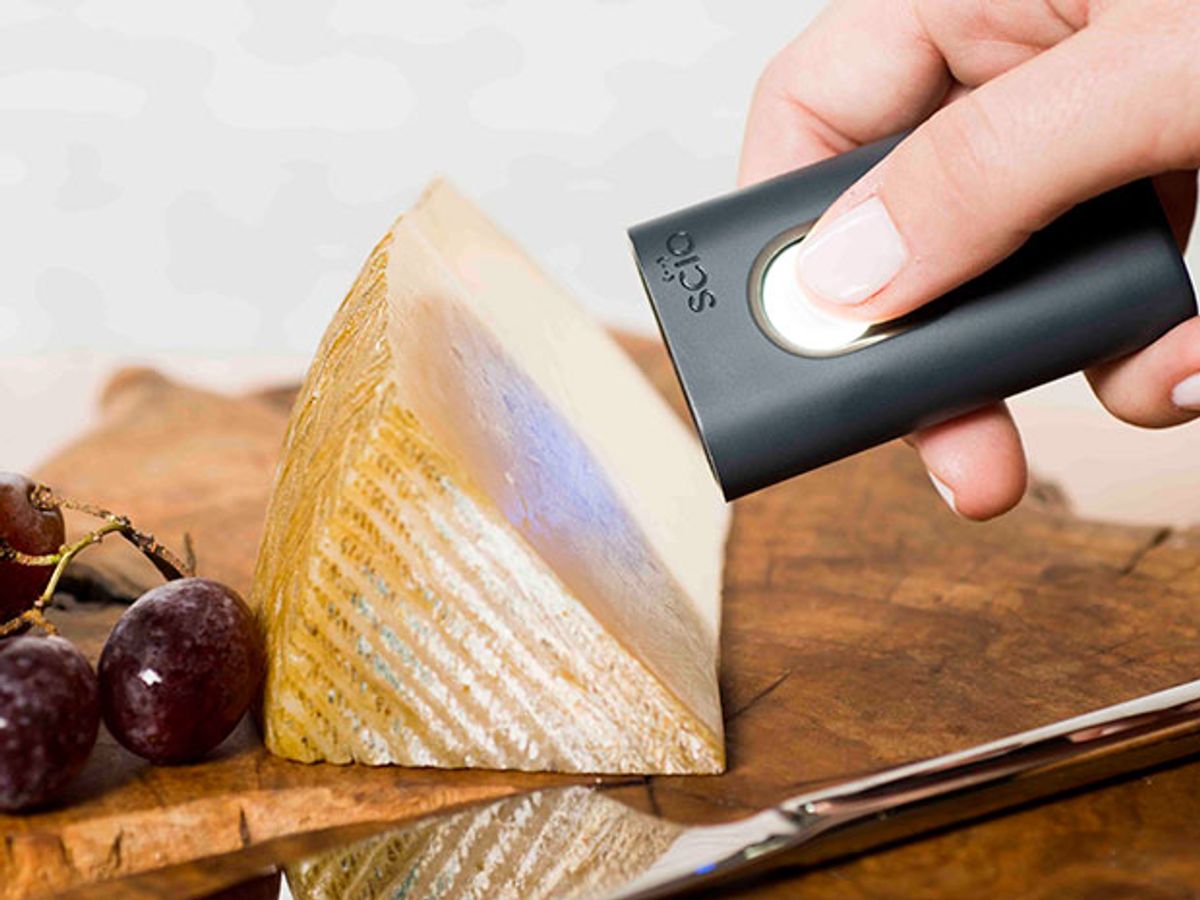Back in 2014, the SCiO seemed like a Kickstarter success story.
The Israeli startup Consumer Physics aimed to raise US $200,000 to fund an initial production run of its handheld spectrometer, the SCiO. With this pocket-size tool, the company said, people could use near-infrared spectroscopy to determine the molecular composition of substances in their everyday lives. For example, they could point the SCiO at a pile of apples at the supermarket and determine which had the highest sugar content.
This tech sounded mighty cool to about 13,000 people, who signed on as Kickstarter backers at various levels: Most pledged between $150 and $300 for a version of the SCiO, while the more ambitious paid between $400 and $1000 for the SCiO plus a developer’s kit. The company’s estimated shipping dates ranged from October 2014 to February 2015. Consumer Physics ended up raising $2.7 million.
Today, the company’s Kickstarter page is down, with a placeholder note saying that SCiO is subject to an intellectual property dispute. And its Facebook page is filled with angry comments from backers who have waited nearly two years for their promised SCiO. For example:
One backer who’s still waiting is Toby Gadd, cofounder of an artisanal chocolate company called Nuance Chocolate. When contacted by IEEE Spectrum, Gadd explains that he hoped to use the SCiO to examine different cocoa beans and check their fat content. That was back when he was setting up his business. Now he says he’s just glad he didn’t count on the tool.
Gadd says he has periodically received emails from the company explaining the latest delay, and promising shipment soon. But he no longer trusts that the company can mass-produce the device, and he wonders if they’re buying time while they figure out what to do. “That’s where you get into the scam zone,” he says. “If it is a scam, I don’t think that was their intention from the get-go. I think they were well-meaning people who just blew it.”
So what’s going on?
Dror Sharon, CEO of Consumer Physics, tells Spectrum that the company’s delays stem from an unanticipated redesign. “We started to ship units in April 2015, but as we ramped up production we discovered issues—sometimes with our parts, sometimes with our designs,” he says.
These things can happen when you’re trying to make something groundbreaking, says Sharon: “I don’t want to say it’s normal delays, because it’s not a normal product.” The company had to make a new optical sensor that could be mass-produced, and then integrate it into a consumer gadget. “This is not standard manufacturing,” he says. “You can’t just go to China and get a mold.”
Sharon says the company is getting back on track, though, and has now shipped 5,000 units. He hopes to ship to the remaining 8,000 Kickstarter backers by the end of the year.
He also notes that the company made a conscious decision to ship to developers first, in hopes of creating a thriving app ecosystem that would benefit all users. (That ecosystem has yet to materialize, but Sharon says developers are hard at work.) Sharon says the company told its Kickstarter backers about this strategy and received their support.
That missive must have gone out before Kickstarter took down the SCiO campaign page in May 2016. Since then, communication has gotten trickier.
Kickstarter blocked the page because of a trademark dispute regarding the “SCiO” name, Sharon says. He says his company knew about the existence of a company named SCIO Health Analytics long ago, but he says trademark laws permit duplicate names as long as they don’t create confusion in the marketplace. “You can have Delta Airlines, Delta Air Compressors, Delta Refrigeration,” he says.
Nevertheless, a trademark dispute with the other SCIO has turned into a legal matter, and Kickstarter is sensitive on such issues. Since the SCiO page came down, the company has had a harder time communicating with its backers, Sharon says.
The backers who have complained on the company’s Facebook page also include people who have received their SCiOs but are disappointed. For example:
Sharon says the company takes every complaint seriously, and that its customer service department has been responding to the negative comments on Facebook. Sharon also says the company has tried to make clear that people aren’t going to get a working Tricorder, and that the device’s functions will be limited until more apps are developed for SCiO. Kickstarter backers will get free access to all the apps that Consumer Physics develops itself.
It may be that there are many satisfied customers out there, happily scanning apples at the supermarket, and they’re just not very vocal. But one unboxing video on YouTube comes from an enthusiastic backer who bought the developer kit and seems perplexed by the device. After scanning a potato a few times, he gives up and heads off to do some research. He promises to make another video after he’s figured out how to use the SCiO. He apparently hasn’t made that video yet.
Another unboxing video comes from a man who describes himself as a good friend of Sharon’s. He praises the design and is impressed with how well it works straight out of the box. He and a colleague demonstrate the SCiO’s existing food app, which has categories to process info about a few different types of food. They use the dairy category to scan milk and half-and-half, learning their fat content, and use the fruit category to get nutritional data about an apple, a pear, and a lemon. “This exceeded my expectations,” he says.
But those unboxers also go rogue and scan a peanut M&M, although the chocolate category isn’t ready yet. Instead, they use the category for pain relievers and get back this information: “Main active ingredient: Ibuprofen.”
Eliza Strickland is a senior editor at IEEE Spectrum, where she covers AI, biomedical engineering, and other topics. She holds a master’s degree in journalism from Columbia University.







